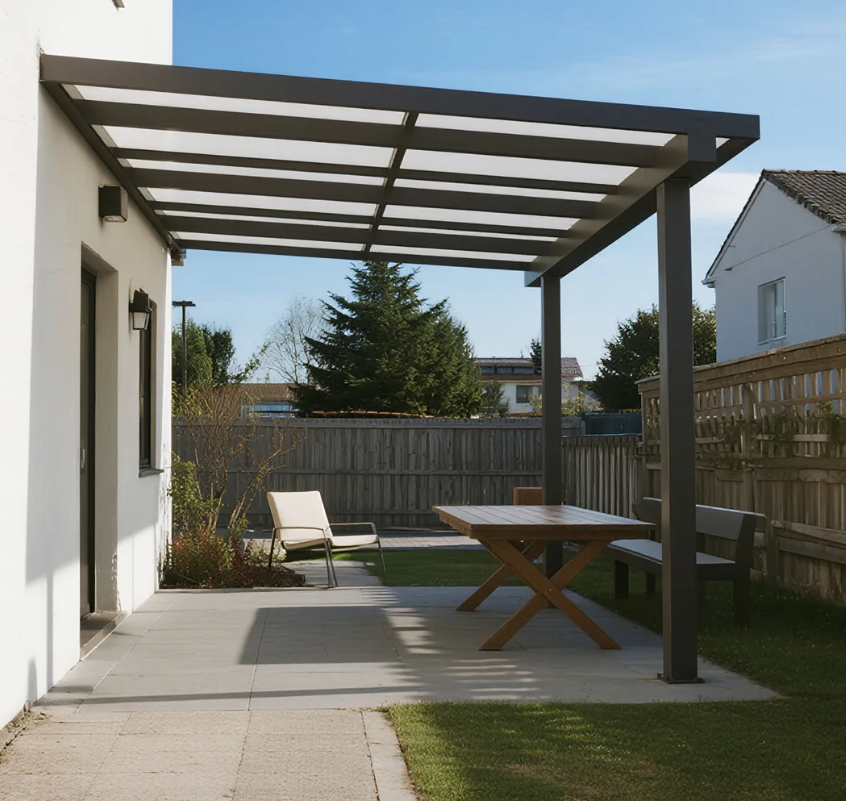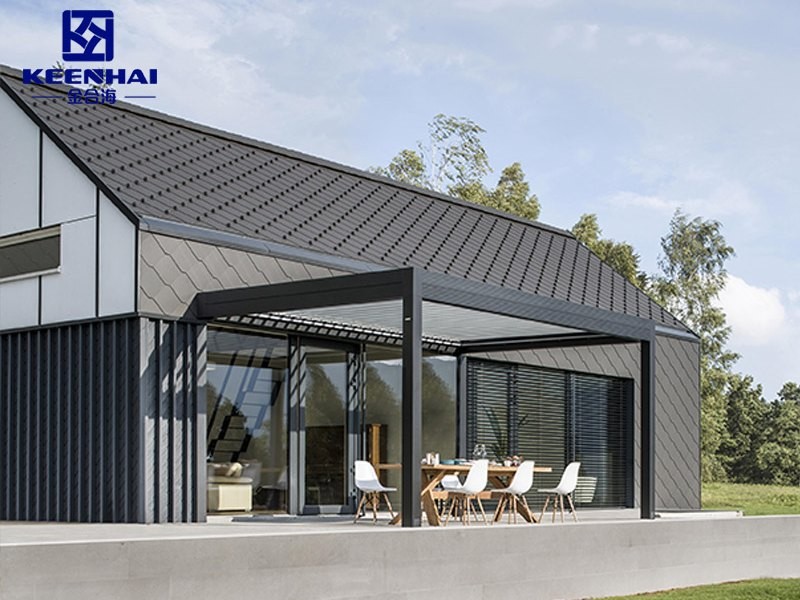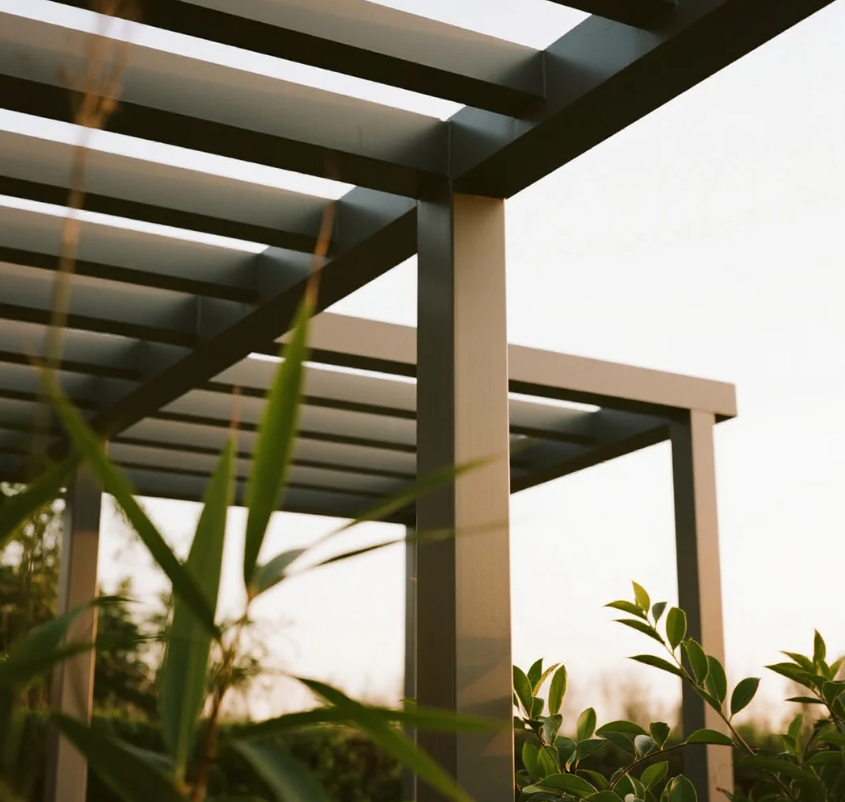
Weather Resistance of Aluminum Pergolas
Performance in Heavy Rain and Moisture
Aluminum pergolas are built to handle relentless downpours without losing structural integrity. Unlike wood, which can swell, crack, or rot when exposed to water, aluminum is inherently non-porous and water-resistant. The material does not absorb moisture, eliminating the risks of warping or surface degradation that plague timber pergolas.
High-end aluminum pergolas often feature seamless gutter systems integrated into the frame, directing rainwater efficiently through hidden drainage channels. This design prevents water from pooling on the louvers or structural beams, which is a common issue in lower-quality models.
When considering moisture resistance, aluminum pergolas with a powder-coated finish outperform anodized aluminum in coastal regions, where salt-laden air accelerates corrosion. Powder coatings typically range from 60 to 80 microns in thickness, providing a durable barrier against water and humidity.
For customers seeking a multi-functional outdoor structure that resists rain, the Aluminum pergola sunshade combines water-shedding louvers with a robust aluminum framework designed for year-round use.
Resistance to Strong Winds and Storms
When storms hit, the last thing you want is an unstable outdoor structure. Aluminum pergolas engineered with wind resistance in mind can withstand gusts up to 100-120 mph, depending on anchoring methods and beam thickness. Pergolas crafted with 6063-T6 aluminum alloy offer superior tensile strength, ensuring they remain stable even under severe wind loads.
Here’s what makes a wind-resistant aluminum pergola effective:
-
Heavy-duty columns with wall thickness between 2.5 mm to 3.5 mm provide the backbone for resisting lateral forces.
-
Deep-set footings, embedded 18 to 24 inches into concrete, anchor the pergola securely to prevent uplift.
-
Louver systems with locking mechanisms minimize movement during high winds, keeping the pergola intact without rattle or shake.
An Aluminum Gazebo like this model is designed to meet these specifications, making it a reliable option for regions prone to hurricanes or strong seasonal storms.
Let’s break down a quick comparison:
| Material Type | Wind Resistance Capacity | Maintenance Requirements | Lifespan Estimate |
|---|---|---|---|
| Standard Wood Pergola | 40-60 mph | High (repainting, sealing) | 10-15 years |
| Galvanized Steel Pergola | 80-100 mph | Medium (coating checks) | 15-20 years |
| Aluminum Pergola (Powder-Coated) | 100-120 mph | Low (simple cleaning) | 25-30 years |
Durability Under Prolonged Sun Exposure (UV Resistance)
Prolonged UV exposure can wreak havoc on outdoor structures, leading to color fading, material brittleness, and eventual failure. Aluminum pergolas, especially those with architectural-grade powder coatings, exhibit exceptional resistance to UV radiation. The finish protects not only the aesthetic appeal but also the material’s structural integrity.
Powder-coated aluminum maintains 95% of its original color after five years of direct sun exposure, based on ASTM G155 Xenon Arc testing standards. Unlike vinyl or painted steel, powder coating bonds chemically with the aluminum surface during curing at temperatures of 390°F (200°C), ensuring long-lasting UV protection.
For outdoor areas exposed to relentless sunlight, a louvered Aluminum Pergola Sunshade allows homeowners to adjust the slats and control sunlight penetration, reducing heat accumulation while preserving the pergola’s finish.
UV degradation not only impacts appearance but also the temperature resistance of outdoor structures. Aluminum pergolas maintain surface stability up to 300°F (149°C), unlike PVC or fiberglass alternatives that warp at lower thresholds.

Corrosion and Rust Protection Features
Natural Anti-Rust Properties of Aluminum
Aluminum has a natural defense mechanism against rust that makes it far superior to materials like steel when used in outdoor structures. When exposed to oxygen, aluminum forms a microscopic oxide layer that bonds tightly to the surface, creating an automatic barrier against moisture and air. This oxidation process is self-repairing, meaning if the surface gets scratched, the oxide layer reforms almost instantly.
For homeowners in coastal regions where salty air accelerates corrosion in traditional metals, an Aluminum Pergola is a solid choice because it doesn’t need galvanization or chemical treatments to stay rust-free. The natural oxide layer is only 2-3 nanometers thick, but it's incredibly effective at blocking the elements.
In contrast, steel requires intensive coatings and constant upkeep to avoid rust. This inherent rust resistance is why marine-grade aluminum (typically 6061 or 6063 alloys) is used in boat manufacturing, proving its toughness in the harshest environments.
Protective Coatings and Finishes for Extra Durability
While raw aluminum offers decent protection, high-quality pergolas go a step further by applying architectural-grade powder coatings that dramatically increase surface durability. These coatings serve multiple functions: they block UV rays, prevent chemical reactions with pollutants, and provide a thicker, impact-resistant shell.
Here’s what sets premium powder-coated aluminum apart:
-
Coating Thickness: Ranges from 60 to 100 microns, double that of standard spray paints.
-
Curing Temperature: Heated at 390°F (200°C) to fuse the powder to the aluminum surface.
-
Salt Spray Resistance: Can withstand over 1,500 hours in ASTM B117 salt spray tests without surface blistering or corrosion.
If you’re looking for a pergola that’s specifically designed to endure corrosive coastal climates, the Aluminum Pergola Sunshade offers powder-coated finishes that are tested to marine-grade standards.
Unlike painted surfaces that chip and peel, powder-coated aluminum maintains its finish for 15-20 years with minimal maintenance. You don’t have to worry about repainting or sealing every few years like you would with wood or steel structures.
Maintenance Tips to Prevent Corrosion Over Time
Even though aluminum is low-maintenance, regular upkeep will help preserve its appearance and performance for decades. Follow these straightforward steps to keep your aluminum pergola in pristine condition:
-
Clean the structure every 3 to 6 months using mild soap, warm water, and a soft sponge. Avoid abrasive pads or harsh chemicals that could scratch or dull the coating.
-
Inspect all joints, screws, and fasteners once a year. Tighten loose connections to prevent structural stress that could cause surface damage.
-
Flush the built-in drainage channels (if present) to remove leaves, dirt, or debris that might trap moisture against the aluminum.
-
For pergolas located near industrial zones or the ocean, apply a protective wax sealant once a year to enhance the powder coating's resistance to airborne chemicals and salt particles.
For homeowners who prefer a hassle-free solution, Aluminum Gazebos with pre-treated anti-corrosion coatings are a smart investment. These structures come with finishes designed to last in challenging outdoor conditions without the need for frequent touch-ups or special treatments.

Structural Strength and Load-Bearing Capacity
Handling Snow Loads and Debris Accumulation
Snow accumulation can cause serious damage to outdoor structures that aren't designed for weight-bearing stress. A well-engineered aluminum pergola is capable of supporting snow loads ranging from 20 to 40 pounds per square foot, depending on the specific model and beam thickness. For example, pergolas made from 6063-T6 aluminum alloy with beams measuring 2.5 mm to 3.5 mm thick provide excellent load distribution, allowing the structure to remain stable during heavy snowfalls.
What makes aluminum pergolas stand out is their combination of strength and lightweight design. Steel pergolas may handle similar snow loads but often weigh 30-40% more, making them harder to install and requiring more robust footings. In contrast, aluminum pergolas simplify the installation process without compromising durability.
To ensure safe performance during winter:
-
Choose a pergola with angled or adjustable louvers that allow snow to slide off instead of building up.
-
Opt for a design with built-in drainage channels that prevent water from freezing in joints and causing expansion-related damage.
-
Conduct periodic clearing of leaves, branches, and debris, especially after storms, to reduce unnecessary weight on the structure.
For homeowners in snowy regions, an Aluminum Pergola Sunshade offers both snow-shedding features and reinforced beams, making it a practical solution for year-round outdoor living.
Structural Reinforcements for Extreme Climates
Extreme climates demand more than basic pergola construction. In areas with hurricane-force winds, pergolas need reinforced cross-beams, heavy-duty anchoring systems, and structural bracing to handle the added stress.
Here's how high-quality aluminum pergolas are designed to meet these challenges:
-
Cross-Beam Reinforcements: Beams with internal rib structures or double-wall designs increase torsional rigidity, allowing them to handle lateral forces without flexing.
-
Anchoring Depth: Footings embedded at least 24 inches into concrete slabs, with stainless steel anchor bolts, ensure the pergola stays grounded even under 120 mph wind gusts.
-
Load Distribution Columns: Columns with dimensions of 6x6 inches and wall thickness of 3.5 mm effectively distribute both vertical and lateral loads.
A well-designed Aluminum Pergola can stand up to extreme climates with minimal maintenance, offering both durability and visual appeal.
It's important to note that not all aluminum pergolas are built for harsh weather. Homeowners should always verify structural load ratings and request engineering documents when purchasing for high-risk areas. Some premium models even come with optional storm reinforcement kits, including diagonal braces and louver locking systems for added stability.

Comparison with Other Pergola Materials in Outdoor Conditions
Aluminum vs. Wood: Which Handles Weather Better?
When it comes to outdoor performance, aluminum pergolas dominate wood in every weather condition. Wood, although aesthetically classic, suffers from inherent weaknesses in humid, rainy, and sunny environments. Moisture penetrates wooden structures, leading to rot, warping, and insect infestations within 5 to 10 years without constant maintenance. On the flip side, aluminum pergolas require no sealing, staining, or painting, and maintain structural integrity for 25 to 30 years with simple cleaning.
Temperature fluctuations also take a toll on wood. Wood expands and contracts as temperatures change, causing cracks and splits over time. Aluminum, however, is dimensionally stable; it does not swell or shrink, regardless of the season.
For regions with high humidity or unpredictable weather, an Aluminum Pergola Sunshade provides year-round resilience without the high maintenance burden that wood demands.
Here's a side-by-side comparison to visualize their differences:
| Feature | Aluminum Pergola | Wood Pergola |
|---|---|---|
| Lifespan | 25-30 years | 10-15 years (with heavy maintenance) |
| Maintenance | Low (simple wash) | High (sealing, staining every year) |
| Moisture Resistance | 100% rust-proof, no rot | Susceptible to rot and mold |
| UV Resistance | Powder-coated UV-blocking finish | Fades and cracks under direct sun |
| Insect Damage | Impervious | Vulnerable to termites & pests |
| Cost Over 10 Years | Lower total cost (minimal upkeep) | High upkeep costs accumulate |
Aluminum vs. Steel: Corrosion and Maintenance Differences
While both materials are strong and long-lasting, steel pergolas require far more maintenance to prevent rust and surface deterioration. Steel is heavier and structurally robust, but it’s highly susceptible to corrosion unless it’s galvanized or powder-coated meticulously. Even with treatments, steel pergolas often develop rust at weld joints and fasteners within 5-7 years, especially in coastal or high-humidity regions.
In contrast, aluminum pergolas are naturally rust-proof, offering a distinct advantage in long-term outdoor applications. Aluminum forms a self-protective oxide layer that prevents oxidation without the need for galvanization. Plus, aluminum is significantly lighter than steel—making it easier and less expensive to install while still offering high load-bearing capacity.
Here’s a material performance breakdown:
| Feature | Aluminum Pergola | Steel Pergola |
|---|---|---|
| Corrosion Resistance | Natural oxide barrier + powder coat | Requires galvanizing + coating |
| Maintenance | Minimal (simple surface cleaning) | Medium to High (coating inspections) |
| Weight | Lightweight, easy to install | Heavy, requires reinforced footings |
| Rust Vulnerability | Zero rust in normal conditions | High risk without constant upkeep |
| Lifespan | 25-30 years | 15-20 years (if maintained well) |
| Structural Strength | High with less weight | Superior strength but overbuilt for most residential needs |
